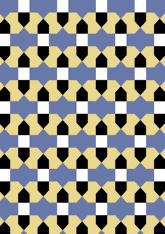Amol, the Mir Qavam al-Din Mar'ashi building
 data197/IRAN16
(Click on image for high-quality PDF version)
data197/IRAN16
(Click on image for high-quality PDF version)
Geometry
- The symmetry group of the tiling is 2*22 (cmm).
- All the internal angles of the constituent polygons are a multiple of 45°.
- Contains one square.
- There are three non-regular reflective tiles.
- The tiling satisfies the interlace condition and has one finite interlace and no infinite interlace with straight cross-overs.
- The tiling is edge-to-edge.
- As drawn, contains about 311 polygons.
References
Publications referenced:
- Page 267, Fig. 140 (Sultan Han, Kayseri, Turkey) of Jay Bonner. Islamic Geometric Patterns, Springer, 2016. ISBN 978144190216. [bonner] {Largest Islamic tile collection in print}(1232-6AD, 629-33AH)
- Page 267, Fig. 140 (Esrefoglu Suleyman Bey, Beysehir, Turkey) of Jay Bonner. Islamic Geometric Patterns, Springer, 2016. ISBN 978144190216. [bonner] {Largest Islamic tile collection in print}(1296-7AD, 695-6AH)
- Vol2, page 176 (Mir Qavam al-Din Mar'ashi, Amol, Iran) of Mahmood Maher al-Naqsh. Design and execution of drawing in Iranian tilework, Islamic period, Reza Abbasi Museum, 1983. [iran] {Good collection of Iranian patterns, text in Persian} Available on Internet.
Collections of similar tilings
Patterns using same irregular tiles: 2
v54

